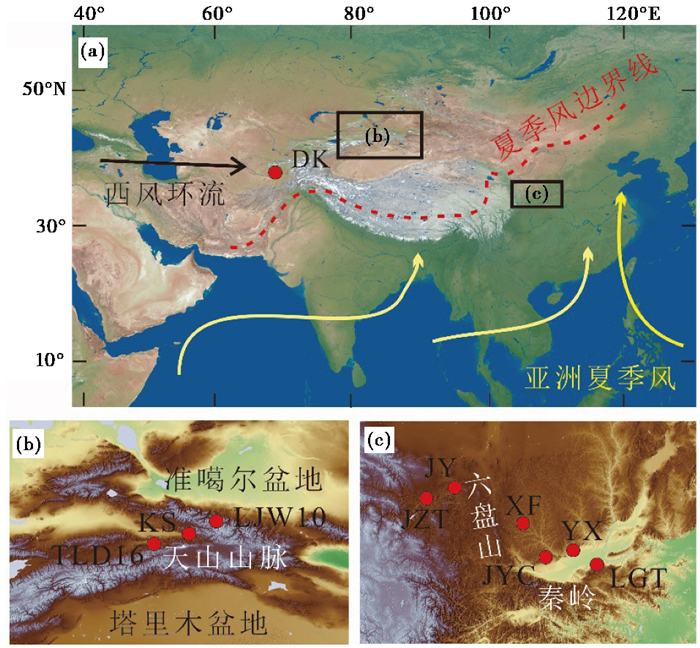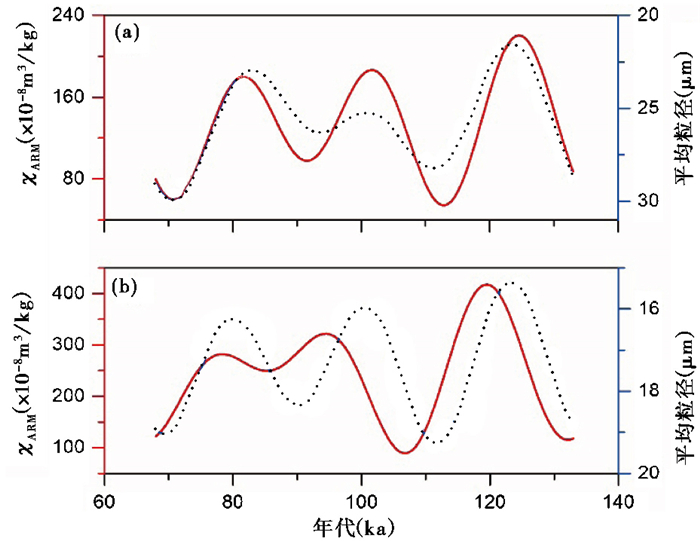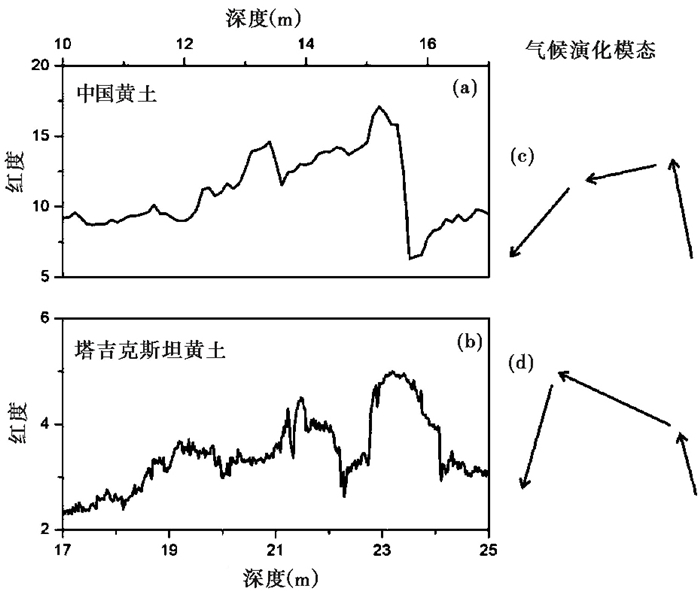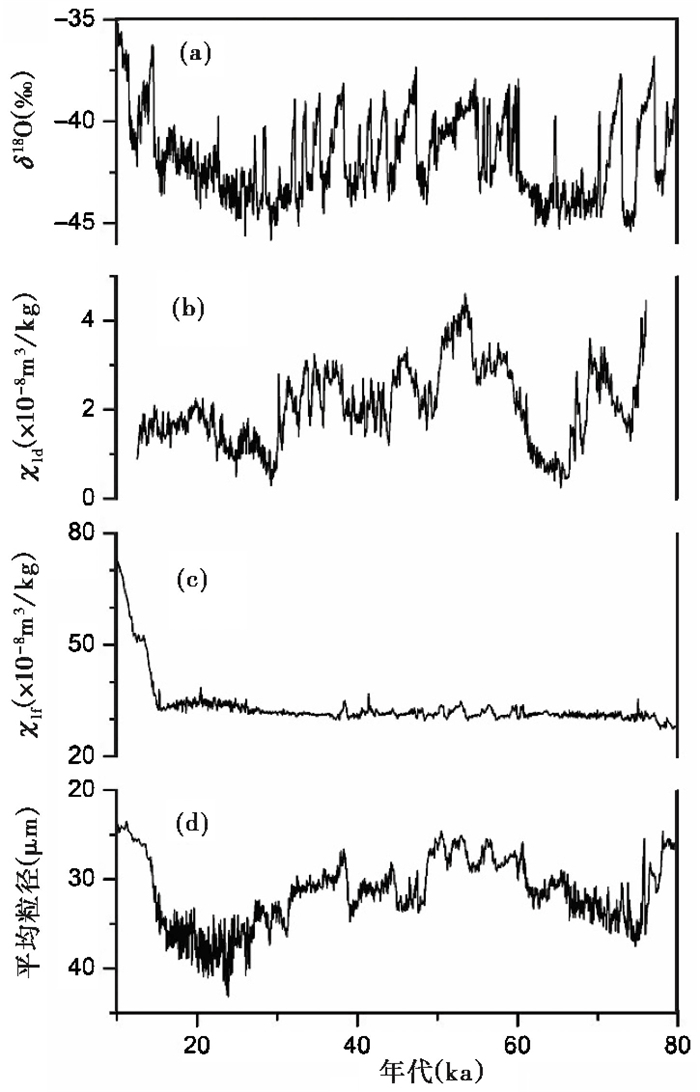亚洲中纬度地区存在两大环流系统——西风环流和季风环流,分别是大陆西部和东部的重要水汽输送者[1]。受季风环流影响深刻的大陆东部被称为季风区,其气候湿润,雨热同期,农业以耕作业为主,人口稠密;受西风环流影响深刻的大陆西部被称为西风区,其气候相对干旱,降水通常发生在冬春季,农业以畜牧业为主,人口稀疏。
已有研究发现,虽然中亚地区气候呈现冰期干旱、间冰期湿润的气候模态[2]。但在年代际至亚轨道尺度,西风区的气候演化模态与季风区存在明显差异[1, 3~5]。近50年的降水观测显示,东亚季风区呈现变干趋势,西风区呈现变湿趋势[4]。代用指标显示这种反相位的气候演化格局存在于多百年至千年尺度:中亚地区在中世纪暖期干旱,而小冰期湿润;与季风区相反[5]。无独有偶,在受西风环流控制的北美洲中纬度西岸同样存在类似的、与大陆东岸相反的气候演化模态[6]。此类地质证据的不断出现驱使我们去了解在更长尺度大陆中纬度气候演化的空间格局。
至中更新世(开始于0.8Ma),全球气候发生了深刻的变化,突出体现在气候变化主周期由4万年变为约10万年[7]。中更新世内最重要的气候转型发生在约43万年,即中布容事件之后,表现为冰期-间冰期旋回的冰量的变化幅度更大,即冰期冰量更多,间冰期冰量更少[7];与此相对应,全球大气中CO2含量[8]、亚洲季风强度[9]、极地地区温度[10]、干旱区粉尘释放[9]等的变化更为显著。广泛的地质证据证明,该气候转型是深刻的,且具有全球性的[7~10]。至晚更新世,千年尺度的气候快速波动事件开始频繁出现[11]。在北半球高纬,这些事件导致的温度变化幅度最高可达16℃[11]。这种程度的频率高振幅的气候事件在整个第四纪都是罕见的。在气候快速变化的今天,它们的研究受到广泛关注。本研究试图选择典型黄土序列为研究对象(图 1),对比中更新世以来亚洲中纬度西风区与季风区多千年尺度至轨道尺度气候演化异同,以期深入理解长尺度古气候演化中西风环流和季风环流相互关系。

|
图 1 研究区域(a)和研究剖面位置(b,c)示意图 DK:塔吉克斯坦Darai Kalon剖面;KS:坎苏剖面;TLD16:塔勒德剖面;LJW10:鹿角湾剖面;JY:靖远剖面;JZT:九州台剖面;XF:西峰剖面;JYC:匠杨村剖面;YX:耀县剖面;LGT:老官台剖面 Fig. 1 The locations(b, c)of investigated profiles in mid-latitude Asia (a). DK is Darai Kalon section in Tajikistan, KS is Kansu section, TLD16 is Talede section, LJW10 is Lujiaowan section, JY is Jingyuan section, JZT is Jiuzhoutai section, XF is Xifeng section, JYC is Jiangyangcun section, YX is Yaoxian section, and LGT is Laoguantai section |
Ding和Yang[2, 12]对塔吉克斯坦黄土的调查结果表明:过去的1.8Ma,西风区在间冰期呈现相对温湿的气候状态,在冰期呈现相对冷干的气候状态;该气候演化模态与季风区一致。但是,中布容事件以来间冰期气候演化趋势存在明显差异。
系统的磁学调查结果显示[13]:塔吉克斯坦黄土的主要载磁矿物为纳米粒级的磁铁矿,且其含量变化与地层的土壤发育强度高度一致,即土壤发育越强磁化率越高,反之亦反。这些证据表明,塔吉克斯坦黄土的磁化率增强模式与黄土高原黄土一致,即降水量控制地层的磁化率变化;由此,磁化率可用于恢复区域古降水[13]。黄土沉积的红度主要受控于地层中赤铁矿含量[14];与磁铁矿不同,赤铁矿的形成与温度更为密切,它通常形成于高温高湿的环境[15],但高温和较干旱的环境也可形成数量可观的赤铁矿[16]。因此,同时对比赤铁矿与磁铁矿含量可以得到更丰富的气候信息。塔吉克斯坦黄土磁化率结果显示[17]:自MIS 12之后,间冰期湿度增加的幅度远高于季风区,即中布容事件后的气候转型更为显著(图 2)。由磁化率与红度参数对比分析可知[17]:MIS 11之前,塔吉克斯坦的冰期间冰期气候变化可能主要体现为温度的波动;之后,则可能突出体现为湿度的波动(或湿度和温度的共同波动)(图 2)。值得注意的是:虽然极地冰芯记录中布容事件后的气候转型在温度和大气CO2含量等记录中均十分明显[10],但无论是塔吉克斯坦黄土记录[17]还是中国黄土记录[9],该气候转型更多表现在湿度方面。进一步查看磁化率变化的细节可以发现:MIS 9期是中布容事件之后塔吉克斯坦最湿润的间冰期,也是黄土高原最干旱的间冰期[17](图 2)。野外观察也可以得到相似结论,塔吉克斯坦黄土序列中S3地层颜色深、偏黑;中国黄土序列中S3地层是S5地层之上颜色最浅的古土壤层[9]。相反的湿度状况也出现在MIS 13期(间冰期):中国黄土序列发育了第四纪土壤发育最强的地层S5S1,但在塔吉克斯坦黄土序列中该地层无论是土壤发育的厚度、颜色、结构等均无明显优势,尤其是地层磁化率(图 2)。事实上,MIS 13期以来,西风区与季风区的间冰期气候演化似乎总体呈现相反趋势(图 2)。这个现象十分值得大家注意。

|
图 2 塔吉克斯坦(DK剖面:38°23′04″N,69°50′01″E)和中国黄土(XF剖面:35°46′N,107°41′E)中更新世以来气候演化记录 虚线是间冰期气候演化模态(塔吉克斯坦黄土磁化率数据引自文献[17],中国黄土数据引自文献[9]) Fig. 2 The comparison of climate evolutions recorded by Tajikistan loess(DK section:38°23′04″N, 69°50′01″E)and Chinese loess(XF section: 35°46′ N, 107° 41′E), since mid-Pleistocene. The dash lines indicate the interglacial climate evolution patterns of Tajikistan and Chinese Loess Plateau. The magnetic susceptibility data of DK section is cited from reference[17], and data of XF section is cited from reference [9] |
本研究进一步分析了磁化率和红度的波动周期。小波分析结果显示,中、晚更新世两地的黄土记录均呈现了8万年周期和12万年周期的存在(图 3)。在深海氧同位素(MIS)19~16期,每个冰期间冰期旋回都对应两个黄赤交角周期;而MIS 7~1期,每个冰期间冰期对应3个黄赤交角周期。此外,中国季风区北部的气候演化的第二主周期是4万年的黄赤交角周期,第三主周期是2万年的岁差周期,这在黄土高原中部的西峰剖面(图 3)和西部的靖远剖面都有记录[18~19]。但在塔吉克斯坦黄土磁化率和色度记录中4万年的黄赤交角周期极其微弱,甚至不如2万年的岁差周期明显(图 3)。这个分析结果暗示:在轨道尺度上塔吉克斯坦地区的湿度变化与低纬气团的联系更紧密,而东亚季风区北部地区的湿度变化与高纬气团的联系更紧密。

|
图 3 塔吉克斯坦黄土(DK剖面,磁化率数据来自文献[17])和中国黄土(XF剖面,数据引自文献[9])记录的小波分析图 图中黑线轮廓表示通过5 %的显著性检验,阴影处的分析结果可能受到边界效应影响 Fig. 3 The time series of the parameters, χ and redness, in DK section and XF section. The thick black contour designates the 5 %significance level against red noise and the cone of influence where edge effects might distort the picture is shown as a lighter shade. The magnetic susceptibility data of DK section is cited from reference[17], and data of XF section is cited from reference [9] |
东亚地区的气候变化受到夏(冬)季风强度和位置的共同影响,且二者是正相关关系,即夏季风强,则影响范围向西北方向扩展;反之,向东南方向收缩[20]。中亚地区的西风环流的强度和位置关系应则十分复杂,西风环流是纬向环流,而在冰期-间冰期尺度上的位置变化可能更多为径向移动[17]。西风环流的强度变化应与全球气候变化趋势基本一致,但位置变化受到低纬地区印度季风的强烈影响[17]。印度季风的变化表现出强烈的2万年岁差周期[21]。Chen等[1]猜测由于中亚地区或中亚的部分地区的气候演化对西风环流的位置变化十分敏感。因此其气候记录中2万年周期更为显著。由于西风环流的位置与印度季风的密切关系[4],可以推演在强间冰期,北半球风带气压带相对偏北,中亚地区西风带的位置可能长期处于相对高纬的位置,西风环流强度虽然增加,但是在中亚停留的季节可能缩短,由此造成降水的减少[17]。在弱间冰期,北半球风带气压带相对偏南,中亚地区西风带的位置可能长期处于相对低纬的位置,西风环流强度虽然减少,但是在中亚停留的季节可能增加,由此造成降水的增加[17]。当这种负反馈的强度大于西风环流中水汽含量增加和势力增强的正反馈时,就可能出现在中亚地区的气候演化趋势区别于季风区。由此造成在长尺度上西风区与季风区的间冰期气候演化存在一定的错相位,甚至反相位。
2 间冰期气候演化对比早期的研究已经注意到新疆地区的湿度演化可能是存在明显的区域特性。韩淑媞等[22]提出过新疆地区在全新世呈现“冷干-暖湿”的水热组合特征。Chen和其合作者[1, 3~5]的大量研究表明8ka前后是中亚干旱区湖泊的一个重要发育期。湖泊孢粉结果也显示中亚地区湿度自早全新世逐渐增加至晚全新世[23~24]。这些研究结果共同的启示是,西风区间冰期湿度变化模式可能区别于季风区(早全新世湿润或中全新世湿润,晚全新世干旱[1])。我们试图通过对比西风区与季风区的黄土记录得到更多、更坚实的证据。黄土记录的优势在于:1)在亚洲中纬度地区西风区和季风区的黄土分布区的温度条件较为接近,土壤发育强度与湿度关系更为密切,即指示意义更为明确[2, 17];2)随着释光测年技术的发展,黄土沉积可以获得相对可信的年代控制点。需要注意的是,黄土沉积记录往往与石笋氧同位素记录不一致[25]。近期的大量研究表明,石笋氧同位素可能与水汽源组成有很大关系[25];汪永进和刘殿兵[26]提出其更可能作为ENSO的代用指标,而非降水量。因此,本研究不引入石笋氧同位素结果进行讨论。
Huang及其合作者[27~29]对黄土高原南部全新世黄土沉积序列做了大量调查工作。不同剖面高分辨率的释光测年结果显示古土壤通常发育在9~8ka至3ka[28~29](图 4a)。Chen等[30]基于山西公海高分辨率的重建结果进一步厘定了亚洲中纬度季风区夏季风(降水)的演化历史,由于山西公海的沉积中发现大量陆生植物残体,其年代序列可信度极高。反演结果显示[30]:夏季风在7ka之前波动性增强,3.3ka之后快速衰退,全新世适宜期出现在7.8~5.3ka(降水比现高30 %)。如果将判定适宜期的阈限(降水量)下调,可以发现一个8.5~3.3ka的气候适宜期,这与黄土记录十分相似[27~29]。

|
图 4 (a) 黄土高原(JYC[28]和LGT[29])和天山(TLD16[34]和LJW10[33])高分辨率的黄土剖面测年对比,黑色点表示释光样品的采样深度;(b)天山(LJW10[33])和黄土高原(YX[35])典型黄土剖面记录的湿度演化历史对比 Fig. 4 (a)The comparison of typical Holocene loess stratigraphy of Chinese Loess Plateau loess[28~29] and Tienshan Mountains loess[33~34]. The black dots symbolled the locations of OSL or pIRIR dating samples.(b)The comparison of Holocene moisture evolution between Tienshan Mountain area[33] and Chinese Loess Plateau[35] |
天山地区是中亚黄土的重要分布区[31~32]。Chen等[33]基于长石pIRIR技术和14 C测年结果发现天山地区全新世古土壤发育开始于6ka前后;最新的释光研究结果为该研究提供了更有力的证据[34](图 4a)。代用指标的古气候重建结果显示天山黄土与湖泊[23~24]记录了相似的气候演化过程,即早全新世干旱,湿度在全新世逐渐增加,晚全新世环境最为湿润[33];气候演化滞后于黄土高原地区约3ka以上[35~36](图 4b)。
为进一步调查亚洲中纬度西风区与季风区湿度在间冰期演化的异同,本研究对比了二者在间冰期的演化历史。全新世黄土在区域气候演化对比方面的优势是可以获得较准确的实测年代,劣势是不能刻画一个完整的间冰期。而研究更早的间冰期则可以弥补这一遗憾,但需要更多的办法来解决年代可信度问题。Jia等[36]在天山地区KS剖面末次间冰期黄土的调查工作显示,湿度代用指标(非磁滞剩磁磁化率,χARM)与粒度代用指标的曲线变化呈现错位相的关系(图 5b)。这与黄土高原的调查结果完全不同[37](图 5a)。由于亚洲黄土沉积的粒度与北半球高纬度冰盖面积密切相关[38~40],我们有理由相信黄土高原黄土与天山黄土的粒度变化是同步的。由此可以得出,天山黄土记录的湿度变化滞后于黄土高原黄土的记录大概3~5ka。

|
图 5 黄土高原末次间冰期黄土沉积硫化率(实线)和平均粒径(虚线)记录(a,JZT剖面,数据来源文献[37])与天山黄土硫化率(实线)和平均粒径(虚线)记录(b,KS剖面,数据来源文献[36])对比 Fig. 5 (a)Inphase variations of χARM (solid line)and mean grain-size(dotted line) for the JZT section and the data is cited from reference[37]; (b)Out-of-phase variations of χARM(solid line)and mean grain-size (dotted line) curves for the KS section and the data is cited from reference[36] |
塔吉克斯坦末次间冰期黄土记录的气候演化与中国黄土(黄土高原)记录[9]也存在差别(图 6),其气候代用指标指示的每个旋回(对应于岁差周期)都可以分解为:气候状况快速变好、气候状况缓慢改善以及较快速的气候恶化等3个阶段;而中国黄土记录也可以分解为3个阶段:气候状况快速变好、气候状况逐渐恶化以及气候状况快速恶化。显而易见,二者最大差别在于气候平稳期的气候演化趋势是相反的。需注意的是,这种关系可能仅存在于间冰期的岁差周期,在更长的周期上表现并不明显。

|
图 6 黄土高原末次间冰期黄土沉积记录(a,XF剖面)与塔吉克斯坦黄土记录(b,DK剖面)对比 XF剖面数据数据来源文献[9],DK剖面数据来自本文;(c)和(d)分别是XF和KS剖面岁差周期气候演化的基本模态 Fig. 6 The comparison of Chinese Loess Plateau(a) and Tajikistan(b) last interglacial loess deposits, and the climate evolution models of them(c and d). The data of XF section is cited from reference [9] |
模拟研究结果表明西风环流的强度和位置,以及上风向洋面温度等因素可以有效控制中亚地区的湿度[41]。基于西风区与季风区湿度演化错相位的地质记录,我们推测:上文所述的存在于轨道尺度的负反馈机制同样可能作用于亚轨道尺度的气候变化,从而造成在某些间冰期内部西风区与季风区气候演化的非同相位。
3 末次冰期千年尺度气候快速变化事件对比末次冰期存在一系列频率、大振幅的气候快速变化事件,即D-O事件[11]。D-O事件在中国石笋[42~43]等记录中有明显体现。黄土沉积的粒度(东亚冬季风代用指标[44])或与冬季风有关的其他指标也展示出明确的D-O事件信号[45~46]。但它在磁学参数、有机质同位素等与降水相关的代用指标中则极难捕捉[47~48](图 7)。然而,我们在塔吉克斯坦的工作显示,反映湿度的磁化率、频率磁化率等参数都可以轻易捕捉D-O事件[49](图 7b)。这至少表明,中亚地区的D-O事件的气候振幅要比季风区大得多。所有的D-O事件在间冰阶均显示湿润气候,表明在冰期西风区与季风区的气候演化模态是基本一致的(图 7b)。我们推测,冰期时西风环流强度和上风向海表温度是影响中亚地区湿度变化的主要因素,其气候变化具有明显的全球性。

|
图 7 末次冰期黄土记录的D-O事件及其与NGRIP氧同位素记录对比 (a)NGRIP氧同位素记录[11],(b)塔吉克斯坦黄土DK剖面记录[49],(c)和(d)为中国黄土靖远剖面记录[47] Fig. 7 The comparison of millennial-scale climate oscillations recorded by Greenland ice core(a, NGRIP oxygen isotope), Tajikistan loess(b, DK section), Chinese Loess Plateau loess (c and d, JY section). The data of NGRIP, DK and JY loess sections are citedfrom references[11], [49] and [47], respectively |
本研究通过分析对比中亚和中国黄土高原黄土序列记录的古气候演化历史得出以下结论:
(1) 在轨道尺度上,虽然前人研究发现中亚地区气候演化呈现冰期干、间冰期湿的气候演化模态,与季风区一致。但二者的间冰期气候演化的整体趋势存在明显差别,尤其MIS 13以来,二者的演化趋势基本相反;且中亚黄土记录的黄赤交角周期十分微弱与黄土高原记录不同。
(2) 在间冰期的多千年至万年尺度上,释光测年结果显示中亚地区气候演化滞后于中国黄土高原约3~5ka,该现象在全新世和末次间冰期均有显示。
(3) 在末次冰期中亚地区黄土记录了多次千年尺度气候快速波动事件。这些气候事件表现为间冰阶湿润、冰阶干旱的气候模态,与中国黄土高原一致。但通过相同古气候代用参数的比较可知,中亚地区湿度的波动幅度明显大于中国黄土高原。
上述黄土记录表明西风区间冰期古气候演化具有明显的区域性特征,区别于季风区;冰期古气候则与季风区基本一致,但湿度波动幅度更大。
致谢: 感谢审稿专家建设性的修改意见,使文章得以完善。
| [1] |
Chen F H, Yu Z C, Yang M L, et al. Holocene moisture evolution in arid Central Asia and its out-of-phase relationship with Asian monsoon history[J]. Quaternary Research, 2008, 27(3): 351-364. |
| [2] |
Ding Z L, Ranov V, Yang S L, et al. The loess record in Southern Tajikistan and correlation with Chinese loess[J]. Earth and Planetary Science Letters, 2002, 200(3-4): 387-400. DOI:10.1016/S0012-821X(02)00637-4 |
| [3] |
Huang W, Chen J H, Zhang X J, et al. Definition of the core zone of the "westerlies-dominated climatic regime", and its controlling factors during the instrumental period[J]. Science China:Earth Sciences, 2015, 58(5): 676-684. DOI:10.1007/s11430-015-5057-y |
| [4] |
Huang W, Chen F H, Feng S, et al. Interannual precipitation variations in the mid-latitude Asia and their association with large-scale atmospheric circulation[J]. Chinese Science Bulletin, 2013, 58(32): 3962-3968. DOI:10.1007/s11434-013-5970-4 |
| [5] |
Chen F H, Chen J H, Holmes J, et al. Moisture changes over the last millennium in arid Central Asia:A review, synthesis and comparison with monsoon region[J]. Quaternary Science Reviews, 2010, 29(7-8): 1055-1068. DOI:10.1016/j.quascirev.2010.01.005 |
| [6] |
Graham N E, Ammann C M, Fleitmann D, et al. Support for global climate reorganization during the "Medieval Climate Anomaly"[J]. Climate Dynamics, 2011, 37(5-6): 1217-1245. DOI:10.1007/s00382-010-0914-z |
| [7] |
Lisiecki L E, Raymo M E. A Pliocene-Pleistocene stack of 57 globally distributed benthic δ18O records[J]. Paleoceanography, 2005, 20: PA1003. DOI:10.1029/2004PA001071 |
| [8] |
Lüthi D, Le Floch M, Bereiter B, et al. High-resolution carbon dioxide concentration record 650, 000-800, 000 years before present[J]. Nature, 2008, 453: 379-382. DOI:10.1038/nature06949 |
| [9] |
Guo Z T, Berger A, Yin Q Z, et al. Strong asymmetry of hemispheric climates during MIS -13 inferred from correlating China loess and Antarctica ice records[J]. Climate of the Past, 2009, 5(1): 21-31. DOI:10.5194/cp-5-21-2009 |
| [10] |
EPICA Community Members. Eight glacial cycles from an Antarctic ice core[J]. Nature, 2004, 429(6992): 623-628. DOI:10.1038/nature02599 |
| [11] |
North Greenland Ice Core Project Members. High-resolution record of Northern Hemisphere climate extending into the last interglacial period[J]. Nature, 2004, 431(7005): 147-151. DOI:10.1038/nature02805 |
| [12] |
Yang S L, Ding Z L. Winter-spring precipitation as the principal control on predominance of C3, plants in central Asia over the past 1.77 Myr:Evidence from δ13C of loess organic matter in Tajikistan[J]. Palaeogeography, Palaeoclimatology, Palaeoecology, 2006, 235(4): 330-339. DOI:10.1016/j.palaeo.2005.11.007 |
| [13] |
邓成龙, 刘青松, 潘永信, 等. 中国黄土环境磁学[J]. 第四纪研究, 2007, 27(2): 193-209. Deng Chenglong, Liu Qingsong, Pan Yongxin, et al. Environmental magnetism of Chinese loess-paleosol sequences[J]. Quaternary Sciences, 2007, 27(2): 193-209. DOI:10.3321/j.issn:1001-7410.2007.02.005 |
| [14] |
Sun Y B, He L, Liang L J, et al. Changing color of Chinese loess:Geochemical constraint and paleoclimatic significance[J]. Journal of Asian Earth Sciences, 2011, 40(6): 1131-1138. DOI:10.1016/j.jseaes.2010.08.006 |
| [15] |
Torrent J, Barron V, Liu Q S. Magnetic enhancement is linked to and precedes hematite formation in aerobic soil[J]. Geophysical Research Letters, 2006, 33: L02401. DOI:10.1029/2005GL024818 |
| [16] |
Gao X B, Hao Q Z, Wang L, et al. The different climatic response of pedogenic hematite and ferrimagnetic minerals:Evidence from particle-sized modern soils over the Chinese Loess Plateau[J]. Quaternary Science Reviews, 2018, 179: 69-86. DOI:10.1016/.quascirev.2017.11.011 |
| [17] |
Jia J, Lu H, Wang Y J, et al. Variations in the iron mineralogy of a loess section in Tajikistan during the mid-and Late Pleistocene:Implications for the climatic evolution in Central Asia[J]. Geochemistry, Geophysics, Geosystems, 2018, 19(5): 1244-1258. |
| [18] |
Sun Y B, Yin Q Z, Crucifix M, et al. Diverse manifestations of the mid-Pleistocene climate transition[J]. Nature Communications, 2019, 10. DOI:10.1038/s41467-018-08257-9 |
| [19] |
李涛, 李高军. 斜度驱动第四纪冰期-间冰期转换——来自中国黄土的证据[J]. 第四纪研究, 2018, 38(5): 1111-1119. Li Tao, Li Gaojun. Obliquity pacing of deglaciations in the Pleistocene:Evidence from the Chinese loess deposits[J]. Quaternary Sciences, 2018, 38(5): 1111-1119. |
| [20] |
Chen J, Huang W, Jin L Y, et al. A climatological northern boundary index for the East Asian summer monsoon and its interannual variability[J]. Science China:Earth Sciences, 2018, 61(1): 13-22. DOI:10.1007/s11430-017-9122-x |
| [21] |
Clemens S C, Prell W L. Late Pleistocene variability of Arabian Sea summer monsoon and continental aridity:Eolian records from the lithogenic component of deep-sea sediment[J]. Paleoceanography, 1990, 5(2): 109-145. DOI:10.1029/PA005i002p00109 |
| [22] |
韩淑媞, 吴乃锜, 李志中. 晚更新世晚期北疆内陆型气候环境变迁[J]. 地理研究, 1993, 12(2): 47-54. Han Shuti, Wu Naiqi, Li Zhizhong. Environmental change of inland-type climate during the late period of Late-Pleistocene in Northern Xinjiang[J]. Geographical Research, 1993, 12(2): 47-54. |
| [23] |
Wang W, Feng Z D. Holocene moisture evolution across the Mongolian Plateau and its surrounding areas:A synthesis of climatic records[J]. Earth-Science Reviews, 2013, 122: 38-57. DOI:10.1016/j.earscirev.2013.03.005 |
| [24] |
Leroy S A G, López-Merino L, Tudryn A, et al. Late Pleistocene and Holocene palaeoenvironments in and around the middle Caspian basin as reconstructed from a deep-sea core[J]. Quaternary Science Reviews, 2014, 101: 91-110. DOI:10.1016/j.quascirev.2014.07.011 |
| [25] |
Liu J B, Chen J H, Zhang X J, et al. Holocene East Asian summer monsoon records in Northern China and their inconsistency with Chinese stalagmite δ18O records[J]. Earth-Science Reviews, 2015, 148: 194-208. DOI:10.1016/j.earscirev.2015.06.004 |
| [26] |
汪永进, 刘殿兵. 亚洲古季风变率和机制的洞穴石笋档案[J]. 科学通报, 2016, 61(9): 938-951. Wang Yongjin, Liu Dianbing. Speleothern records of Asian paleomonsoon variability and mechanisms[J]. Chinese Science Bulletin, 2016, 61(9): 938-951. |
| [27] |
Huang C C, Pang J L, Chen S E, et al. Holocene dust accumulation and the formation of polycyclic cinnamon soils(Luvisols)in the Chinese Loess Plateau[J]. Earth Surface Processes and Landforms, 2003, 28(12): 1259-1270. DOI:10.1002/(ISSN)1096-9837 |
| [28] |
贾耀锋, 黄春长, 庞奖励, 等. 关中盆地西部黄土剖面年代序列及其记录的成壤环境演变[J]. 地理科学, 2010, 30(3): 458-464. Jia Yaofeng, Huang Chunchang, Pang Jiangli, et al. Chronosequence of loess section and evolution of pedogenic environment in western Guanzhong Basin[J]. Scientia Geographica Sinica, 2010, 30(3): 458-464. |
| [29] |
Jia Y F, Huang C C, Pang J L, et al. Chronology of the Holocene loess-paleosol section and its deposition and pedogenesis on the south of Chinese Loess Plateau[J]. Journal of Geographical Sciences, 2008, 18(4): 425-442. DOI:10.1007/s11442-008-0425-6 |
| [30] |
Chen F H, Xu Q H, Chen J H, et al. East Asian summer monsoon precipitation variability since the last deglaciation[J]. Scientific Reports, 2015, 5: 11186. DOI:10.1038/srep11186 |
| [31] |
Song Y G, Chen X L, Qian L B, et al. Distribution and composition of loess sediments in the Ili Basin, Central Asia[J]. Quaternary International, 2014, 334-335: 61-73. DOI:10.1016/j.quaint.2013.12.053 |
| [32] |
Sun J M. Source regions and formation of the loess sediments on the high mountain regions of Northwestern China[J]. Quaternary Research, 2002, 58: 341-351. DOI:10.1006/qres.2002.2381 |
| [33] |
Chen F H, Jia J, Chen J H, et al. A persistent Holocene wetting trend in arid Central Asia, with wettest conditions in the Late Holocene, revealed by multi-proxy analyses of loess-paleosol sequences in Xinjiang, China[J]. Quaternary Science Reviews, 2016, 146: 134-146. DOI:10.1016/j.quascirev.2016.06.002 |
| [34] |
Wang L B, Jia J, Zhao H, et al. Optical dating determined Holocene paleosol development in Yili Basin, arid Central Asia[J]. The Holocene. DOI:10.1177/0959683619831432 |
| [35] |
贾佳, 夏敦胜, 魏海涛, 等. 耀县黄土记录的全新世东亚冬夏季风非同步演化[J]. 第四纪研究, 2009, 29(5): 966-975. Jia Jia, Xia Dunsheng, Wei Haitao, et al. Asynchronous evolution of East Asia summer and winter monsoons of the Holocene recorded by Yaoxian loess[J]. Quaternary Sciences, 2009, 29(5): 966-975. DOI:10.3969/j.issn.1001-7410.2009.05.14 |
| [36] |
Jia J, Gao F Y, Xia D S, et al. Moisture variations in arid Central Asia and its out-of-phase relationship with the Asian Monsoon during MIS 5:Evidence from loess records[J]. Journal of Quaternary Science, 2018, 33(4): 435-443. DOI:10.1002/jqs.v33.4 |
| [37] |
Jia J, Xia D S, Wang Y J, et al. East Asian monsoon evolution during the Eemian, as recorded in the western Chinese Loess Plateau[J]. Quaternary International, 2016, 399: 156-164. DOI:10.1016/j.quaint.2015.04.006 |
| [38] |
Hao Q Z, Wang L, Oldfield F, et al. Delayed build-up of Arctic ice sheets during 400, 000-year minima in insolation variability[J]. Nature, 2012, 490: 393-396. DOI:10.1038/nature11493 |
| [39] |
Ding Z L, Liu T S, Rutter N W, et al. Ice-volume forcing of East Asian winter monsoon variations in the past 800, 000 years[J]. Quaternary Research, 1995, 44(2): 149-159. DOI:10.1006/qres.1995.1059 |
| [40] |
张仲石, 燕青, 张冉, 等. 第四纪北半球冰盖发育与东亚气候的遥相关[J]. 第四纪研究, 2017, 37(5): 1009-1016. Zhang Zhongshi, Yan Qing, Zhang Ran, et al. Teleconnection between Northern Hemisphere ice sheets and East Asian climate during Quaternary[J]. Quaternary Sciences, 2017, 37(5): 1009-1016. |
| [41] |
Jin L Y, Chen F H, Morrill C, et al. Causes of Early Holocene desertification in arid Central Asia[J]. Climate Dynamics, 2012, 38(7-8): 1577-1591. DOI:10.1007/s00382-011-1086-1 |
| [42] |
Wang Y J, Cheng H, Edwards R L, et al. A high-resolution absolute-dated Late Pleistocene monsoon record from Hulu Cave, China[J]. Science, 2001, 294: 2345-2348. DOI:10.1126/science.1064618 |
| [43] |
王权, 汪永进, 刘殿兵, 等. DO3事件的湖北神农架高分辨率年纹层石笋记录[J]. 第四纪研究, 2017, 37(1): 108-117. Wang Quan, Wang Yongjin, Liu Dianbing, et al. The DO3 event in Asian monsoon climates evidenced by an annually laminated stalagmite from Qingtian Cave, Mtt. Shennongjia[J]. Quaternary Sciences, 2017, 37(1): 108-117. |
| [44] |
杨石岭, 丁仲礼. 黄土高原黄土粒度的空间变化及其古环境意义[J]. 第四纪研究, 2017, 37(5): 934-944. Yang Shiling, Ding Zhongli. Spatial changes in grain size of loess deposits in the Chinese Loess Plateau and implications for palaeoenvironment[J]. Quaternary Sciences, 2017, 37(5): 934-944. |
| [45] |
Sun Y B, Clemens S C, Morrill C, et al. Influence of Atlantic meridional overturning circulation on the East Asian winter monsoon[J]. Nature Geoscience, 2012, 5(1): 46-49. DOI:10.1038/ngeo1326 |
| [46] |
孙有斌, 郭飞. 中国黄土记录的季风快速变化[J]. 第四纪研究, 2017, 37(5): 963-973. Sun Youbin, Guo Fei. Rapid monsoon changes recorded by Chinese loess deposits[J]. Quaternary Sciences, 2017, 37(5): 963-973. |
| [47] |
Sun Y B, Wang X L, Liu Q S, et al. Impacts of post-depositional processes on rapid monsoon signals recorded by the glacial loess deposits of Northern China[J]. Earth and Planetary Science Letters, 2010, 289(1-2): 171-179. DOI:10.1016/j.epsl.2009.10.038 |
| [48] |
Rao Z G, Chen F H, Cheng H, et al. High-resolution summer precipitation variations in the western Chinese Loess Plateau during the last glacial[J]. Scientific Reports, 2013, 3: 2785. DOI:10.1038/srep02785 |
| [49] |
Wang Y J, Jia J, Liu H, et al. The magnetic susceptibility recorded millennial-scale variability in Central Asia during last glacial and interglacial[J]. Geophysical Journal International, 2018, 215(3): 1781-1788. DOI:10.1093/gji/ggy378 |
Abstract
The Asia monsoon and westerly are two most important atmosphere circulations in mid-latitude Asia, which climatically dominate Eastern Asia and Central Asia. The previous study discovered the moisture of these two regions varied out-of-phase on multiple scales, from decades to millennium, in the Holocene. Here we investigated their relationships from millenniums to orbital scales since mid-Pleistocene by reviewed our studies recently. The Tajikistan loess is a high-resolution record which documented the climate change since 1.8 Ma. The DK section(38°23'04"N, 69°50'01"E) recorded the climate is humid in the interglacials and arid in the glacials in Central Asia, the pattern of which is similar with Chinese Loess Plateau(CLP) loess record(XF section:35°46'N, 107°41'E). However, by comparison the interglacial climate variation pattern on long time scale, it can be discovered the out-of-phase or anti-phase pattern of climate variations between Central Asia and CLP. The cycle analysis investigation further revealed the weak obliquity cycle and strong precession cycle being recorded by Tajikistan loess contrasting CLP loess. On millenniums scales, the climate variation also exhibited an out-of-phase pattern between Central Asia and CLP during interglacials. The magnetic proxies, combing with OSL dating, from several sections, presented a dry Early Holocene, moderate mid-Holocene, and humid Late Holocene pattern in Central Asia, and a dry Early Holocene, humid mid-Holocene, and dry Late Holocene in CLP. In comparison, the climate change in central Asia lagged about 3~5 ka. The similar phenomenon also can be detected in last interglacial. We further compared the climate change during glacials. The last glacial record from DK section presented several obvious millennium climate events which were corresponding with D-O events. They exhibited humid climate during warm stages and arid climate during cold stages, the pattern was same to that in CLP, but the events were more intensive. From loess records, it can be concluded that the climate change between Central Asia and CLP presents an out-of-phase pattern during interglacials from millenniums to orbital scales since mid-Pleistocene, but in-phase during glacials. We had poor understand of the climate evolution forcing mechanism in the region. More climate modeling investigations need to developing in the future. 2019, Vol.39
2019, Vol.39
